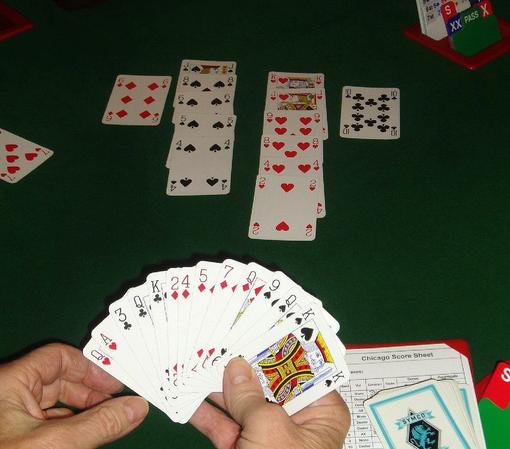
|
Bridge the most popular card game in the world |

The Law of Total Tricks pertains to the card game of contract bridge, and is used to help determine how high to bid in a competitive auction. It is not really a law (because counterexamples are easy to find) but it describes a relationship that seems to exist somewhat regularly. Written by Jean-Ren? Vernes for french players in the fifties as a rule of thumb, it was first described in English in a 1969 magazine article.
The "law" can be stated as follows:
For example, suppose that North-South have an eight-card heart fit and East-West have an eight-card spade fit. The total number of trumps is 16 so the "law" says the total number of tricks is also 16. That is, if North-South can take 8 tricks playing in hearts, then East-West can take 16 - 8 (also 8) tricks playing in spades; if North-South can take 9 tricks in hearts, the "law" says East-West can take only 7 tricks in spades.
The "law" is said to be most accurate when the high card points are fairly evenly divided between the two sides and the bidding is competitive. Experts also apply adjustment factors to improve accuracy.
When one combines the "law" with the scoring table, it turns out that the following is quite often winning strategy:
Thus, if you have an eight-card fit, you are safe to bid to the two level but are unsafe to go to the three level. But, if you have a nine-card fit, the three level will be safe.
In this context, "safe" does not necessarily mean that you will make your contract. But if not, it means you should have a worthwhile save against the opponents' contract. For example, if the opponents have bid to two spades, and you have a nine-card heart fit, the "law" says you should bid three hearts. Assuming the opponents have an eight-card spade fit, there are 17 total trumps. If the opponents can take 8 tricks, the "law" says you can take 9. If the opponents can take 9 tricks, the "law" says you can take only 8. But down one (even doubled, if not vulnerable) is a less negative score for you than letting the opponents make three.
There are a number of bridge conventions that take advantage of the "law". For example, when partner opens one of a major suit (showing five or more in the suit) and you hold four of that suit, a Bergen raise gets you immediately to the three level. (You bid three of partner's major with 0-6 points, three clubs with 7-9 points and three diamonds with 10-12 points.)
In 2002, Anders Wirgren called the accuracy of the "law" into question, saying it works on only 35-40% of deals. However, Larry Cohen remains convinced it is a useful guideline, especially when adjustments are used properly.